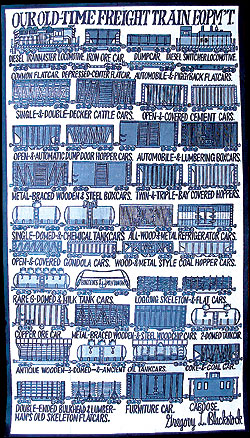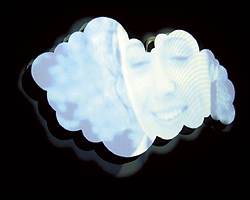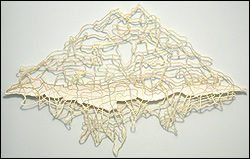I didn’t know what to expect when I arrived at the Garde Rail gallery to interview local artist Gregory Blackstock.
I knew the story—that Blackstock had worked for 25 years at a backbreaking job washing stockpots in the kitchen of the Washington Athletic Club. That he’d begun drawing about 18 years ago and first published some of his illustrations in the WAC newsletter. That he can often be found playing his accordion on the sidewalks outside KeyArena or Nordstrom. That he creates visual catalogs of all sorts of stuff: old-time rail cars, powerboats, police vans, saws, bells, fruits. That he’s a meticulous artist. And that he’s autistic.
We met at the gallery—which focuses on the work of self-trained artists—along with Blackstock’s cousin, Dorothy Frisch, and gallery co-owner Karen Light. Blackstock smiled, gave hugs to Frisch, Light, and the SW photographer, gulped down half a bottle of fruit juice, pulled out a pen, walked straight to his drawing The Historic Outboard Raceboat Equipment, 1950s–1970s, and began adding a few lines to one of the dozen powerboats in the picture.
“Last bit,” he said later. “Finishing touch. A little error-correcting.” And then, “I’ve been to a lot of boat races. I went to the Outboard Nationals for the first time in 1977.” A huge grin spread across his face, and gripping the side of his head like a troublesome Evinrude, he belted out a deafening rendition of a 1970s-era F-class boat: “PARRUMMM! BUM , bum, bum, bum. PARRUMMM! BUM, bum, bum, bum.”
Suddenly he stopped and looked me in the eye. “Twenty Thousand Leagues Under the Sea!” he shouted. “Kirk Douglas! James Mason! Peter Lorre!”
Then he broke into a dead-on mimic of Lorre’s servile whine: “But I thought you were my frieeeeend. . . . “
For the most part, Blackstock makes collections, visual lists. They’re often quite funny, and each is accompanied by deadpan captions: “The Law and Order Authority Vans,” “The Inky Depths Fishes,” “Our State’s King-Size Jails”—all a kind of anthropological study of the everyday. It brings to mind the strange cataloging photographs of water towers by conceptual artists Bernd and Hilda Becher. Not that I brought that up. I was too busy taking notes.
Sometimes my questions provoked appropriate answers, sometimes not. In front of a picture of knots, intricately rendered, I asked if he drew from the real thing.
“Ashley Book of Knots. Clifford Ashley.”
And could he tie any of these knots?
“I don’t have a rope.”
Blackstock works primarily from memory, and he can call up an astonishing visual repertoire. For a piece like The Saws, he visited hardware stores: “I’ve been to every one in the city— Home Depot, Sears, Lowe’s.” Then, having made his initial observations, Blackstock can recall and draw whatever he pleases. Using crayons, pencils, and Sharpie pens on plain paper, he spins out collections of butterflies, roof designs, Our Own Great Irish Joys. He works everywhere: at a tiny desk at home, outside, when he takes a break from the accordion, and on the bus (“Only at the stoplights,” he says).
It was a little over a year ago when Blackstock’s cousin, Frisch, sent a big package of samples to Garde Rail. Co-owner Light had been out of the country; at first, Frisch thought the owners’ silence meant they were cool to the work. But when Light opened the box and began leafing through page after page of drawings, she grabbed the phone. “I was desperate to sign him up,” she said.
No one knew how Blackstock—who had been making art for years—would feel about selling his work. The concern was unfounded. “He’s really embraced the theory of commerce,” said Light. So much so, in fact, that she’s had to gently encourage him not to re-create the pieces that sell. “Once is good,” she kindly suggests.
What’s fascinating about Blackstock’s visual lists is that they reach into the very essence of language and perception. For example, how do our minds recognize: “That’s a bell”? How do we type and categorize the world? How do our brains work, and how does a “different” sort of brain see things with a fresh and startling perspective? The Noise-Makers, one of my favorite pieces, is filled with a funny assortment of loud stuff—a smoke alarm, a thundercloud, a bomb dropping, an antique car horn, a circular saw, and firecrackers. In one corner is an odd, masklike face with a gaping mouth and snakey tongue. The caption reads “LOUD FILTH-MOUTH OFFENDER, THE OVER- EMOTIONAL DIRTBAG.”
Blackstock smiled as he pointed to it. “That’s my own filthy mouth,” he said.
As I gathered my stuff to leave, I asked him about a picture that’s signed “potwasher Gregory L. Blackstock.” It’s an early work, from the late ’90s, when he was still working at the grimy dishwashing job. He was silent a moment.
“That’s one of the few times I’ve seen him speechless,” said his cousin.
“That was in 1999. I’m retired now,” he replied eventually. “An artist.”
“Gregory Blackstock” runs through Feb. 28 at Garde Rail, 110 Third Ave. S., 206-621-1055. 11 a.m.–5:30 p.m. Wed.–Fri.; 11 a.m.–5 p.m. Sat.; and by appointment.







